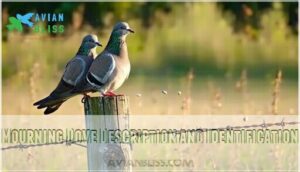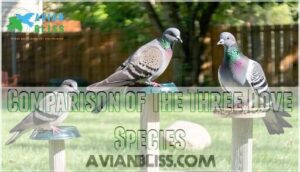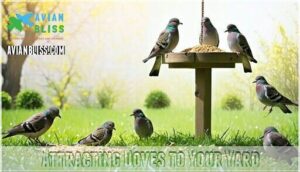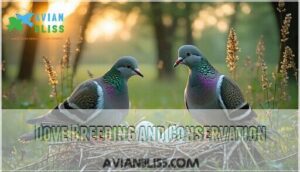This site is supported by our readers. We may earn a commission, at no cost to you, if you purchase through links.

Mourning Doves are slender with soft gray-brown feathers and a mournful coo, often seen in open fields or perched on power lines.
Rock Pigeons, the familiar city dwellers, flaunt iridescent neck feathers and thrive in urban areas.
Eurasian Collared-Doves, slightly larger with a distinctive black neck ring, prefer suburban neighborhoods and farmlands.
All three love seeds, so scattering millet or sunflower seeds in your yard might bring them closer.
Keep an eye out—each species offers a unique glimpse into Illinois’s vibrant birdlife.
Curious for more?
Table Of Contents
- Key Takeaways
- Types of Doves in Illinois
- Dove Habitat and Diet
- Dove Behavior and Ecology
- Attracting Doves to Your Yard
- Dove Breeding and Conservation
- Importance of Doves in Illinois
- Frequently Asked Questions (FAQs)
- What kind of doves live in Illinois?
- Is it good to have doves in your yard?
- What’s the difference between a mourning dove and a turtle dove?
- What is dove season in Illinois?
- What are the predators of doves in Illinois?
- How does urbanization affect dove populations?
- Are doves in Illinois migratory birds?
- What diseases affect doves in Illinois?
- How can I identify dove calls?
- What sounds do White-winged Doves make?
- Conclusion
Key Takeaways
- You’ll find three main dove species in Illinois: Mourning Doves, Rock Pigeons, and Eurasian Collared-Doves, each with unique traits and habitats.
- Mourning Doves are common in open fields, Rock Pigeons thrive in cities, and Eurasian Collared-Doves prefer suburban and farmland areas.
- Doves love seeds like millet and sunflower, so scattering these in your yard can attract them while providing a safe, open feeding area.
- They play a vital role in seed dispersal and ecological balance, but urbanization and habitat loss challenge their populations.
Types of Doves in Illinois
You’ll find three main dove species in Illinois: the common Mourning Dove, the urban-loving Rock Pigeon, and the newer Eurasian Collared-Dove.
Each species has distinct features that’ll help you identify them whether you’re in your backyard or exploring Illinois parks.
Mourning Dove Description and Identification
You’ll spot Illinois’s most common dove species by its distinctive grayishbrown plumage and mournful call.
The Mourning Dove shows subtle plumage variations across seasons, making dove identification straightforward with these key features:
- Black wing spots creating striking patterns against gray-brown feathers
- Pointed tail with white outer edges visible during flight patterns
- Distinguishing calls resembling soft, melancholy "coo-ah-coo-coo-coo" sounds
They are also known for their seed-sipping feeding habits.
Rock Pigeon Characteristics and Habitat
Rock Pigeons show remarkable plumage variation, from blue-gray to rusty-brown or pure white.
You’ll find these adaptable birds thriving in urban areas and suburban areas across Illinois, treating skyscrapers like urban cliffs.
Their habitat includes parks, plazas, and rooftops where feral populations flourish.
These opportunistic feeders enjoy diet scraps from sidewalks and dumpsters.
When numbers grow excessive, cities implement control measures to manage their populations effectively.
Eurasian Collared-Dove Distinctive Features
The Eurasian Collared-Dove stands out with its sandy gray color and distinctive black neck marking bordered by white.
You’ll notice its square-tipped tail differs from other dove species in Illinois.
Listen for their three-note koo-KOO-kook song with emphasis on the middle syllable.
These medium-sized doves measure larger than Mourning Doves, making identification straightforward for Illinois birdwatchers.
Comparison of The Three Dove Species
These three dove species Illinois hosts show clear differences you can use for identification.
Mourning Doves display gray plumage with black wing spots and produce mournful calls.
Eurasian Collared-Doves feature sandy-brown coloring with distinctive black neck rings.
Rock Pigeons showcase varied plumage from gray to white, thriving in urban areas where habitat overlap occurs among these Illinois doves.
They’re often found in backyards, and you can identify them by their distinctive fan-shaped tail.
Dove Habitat and Diet
You’ll find Illinois doves thriving in surprisingly different environments, from Mourning Doves in open fields and suburban yards to Rock Pigeons claiming city rooftops as their territory.
These seed-loving birds have adapted their diets to match their habitats, with some species munching on agricultural grains while others feast on whatever scraps they can find in urban areas.
They have also shown a preference for certain food sources, with some species eating agricultural grains.
Open Habitats for Mourning Doves
Mourning doves thrive in Illinois’ open fields and sparse woodlands, where they practice ground foraging for seeds.
You’ll spot these graceful birds perched on power lines, scanning for their next meal.
They prefer dove habitat Illinois offers like urban parks with brush cover nearby for safety.
Unlike their city-dwelling cousins, mourning dove Illinois populations gravitate toward expansive spaces.
Plant dove attracting plants like sunflowers in your yard’s open areas to create ideal dove fields Illinois conditions for these peaceful visitors.
Urban Areas for Rock Pigeons
Cities become home for Rock Pigeons through remarkable Urban Adaptation.
These City Scavengers thrive on urban areas, transforming city streets into dining halls while raising Public Health concerns.
- Historical Context traces pigeons’ 5,000-year bond with humans
- Population Control addresses overcrowding through management programs
- Urban roosts include ledges, bridges, and building structures
- Food sources range from bird feeders to scattered birdseed
Human-pigeon interactions shape urban ecosystems daily.
Bird feeders can cause altered bird behavior.
Seed Eaters and Omnivores
Illinois doves have seed preferences that make them easy to please at feeders.
Their foraging behavior centers on grains like millet and corn, meeting their nutritional needs perfectly.
While primarily seed-focused, these birds show flexible diet seasonality, occasionally eating berries and greens.
This adaptability prevents crop damage concerns while supporting healthy dove diet patterns through consistent bird feeding opportunities.
Variety of Seeds for Dove Attraction
Different dove species have unique seed preferences that determine your feeding strategies.
Understanding nutritional value helps create effective bird feeding setups year-round, despite seasonal variations in seed availability.
The mix is designed to provide easily accessible seeds on clean dirt for doves.
- Browntop millet: Produces abundant seeds per acre, perfect for dove habitat Illinois management.
- Dove Field Mix: Combines sunflowers and buckwheat for ideal attraction.
- High-oil sunflower varieties: Provide essential fats doves need.
Dove Behavior and Ecology
You’ll notice that doves display fascinating behaviors that reveal their adaptability and ecological importance in Illinois.
These birds serve as living indicators of environmental health while playing vital roles in seed dispersal and food web dynamics across the state’s diverse habitats, highlighting their ecological importance.
Doves showcase remarkable adaptability, serving as peaceful symbols and vital contributors to Illinois’ ecological balance.
Mourning Dove Breeding Patterns
Mourning Doves excel at bird breeding with impressive nesting frequency – you’ll spot up to six broods annually in Illinois.
Their incubation period lasts two weeks, with parents sharing duties.
Brood size typically includes two eggs.
Nestling development progresses rapidly as chicks fledge within 15 days.
This efficient parental care makes dove breeding remarkably successful compared to other bird behavior patterns.
Rock Pigeon Urban Adaptation
You’ll spot Rock Pigeons everywhere in urban environments, from downtown squares to suburban parking lots.
These feral pigeons have mastered city living better than most wildlife. They’ve transformed concrete jungles into their playground, finding urban food sources like dropped sandwiches and spilled snacks.
Their building nesting sites on ledges perfectly mimic their ancestral cliff homes. However, their success brings challenges including disease transmission concerns and the need for population management in busy areas.
Rock Pigeon urban adaptation highlights:
- Urban food sources: Thrive on human leftovers and scraps
- Building nesting sites: Use ledges as natural cliff substitutes
- Human interaction impact: Comfortable around people and crowds
- Population management: Cities often control numbers through various methods
Eurasian Collared-Dove Dispersal
Eurasian Collared-Doves showcase remarkable range expansion across Illinois through multiple dispersal mechanisms.
These invasive species prefer urban areas and agricultural landscapes, creating competitive impacts on native doves.
Their genetic diversity helps them adapt quickly to new environments.
You’ll notice their habitat preferences favor human-modified landscapes, making their bird range expansion particularly successful in developed areas throughout the state.
Doves as Indicators of Ecological Health
Beyond their rapid spread, these adaptable birds serve as living barometers for Illinois ecosystems.
When dove populations shift or show unusual behavior, they’re signaling changes in their environment that affect other wildlife too.
Doves excel as biodiversity indicators because they respond quickly to habitat quality changes.
Here’s what makes them valuable ecological monitors:
- Species sensitivity to pesticide exposure reveals pollution impacts
- Food web connections link their health to broader ecosystem stability
- Bird habitats condition directly affects dove reproduction success
- Bird conservation efforts benefit from dove population monitoring
- Ecological health assessments use dove data for environmental planning
Furthermore, monitoring their populations provides cost-effective monitoring for broader environmental assessments.
Attracting Doves to Your Yard
You can turn your yard into a dove haven by offering the right seeds and feeding setup.
Platform feeders filled with millet and sunflower seeds placed in open areas away from dense shrubs will attract mourning doves, while scattered seeds on the ground will draw rock pigeons in urban settings.
Millet and Sunflower Seeds for Mourning Doves
Your Mourning Doves crave millet and sunflower seeds above all else.
Millet nutrition provides essential carbohydrates, while their sunflower preference delivers vital fats and proteins.
Offer quality seed mixes twice daily to match their natural foraging patterns. You can easily purchase these seeds online.
Store seeds in airtight containers to prevent sprouting seeds that doves won’t touch. Fresh bird feeders support their dove diet perfectly.
Trays and Platforms for Dove Feeding
Tray feeder types and platform feeder design make all the difference for attracting doves in Illinois. These ground-loving birds prefer wide, flat surfaces over tube bird feeders.
Choose platforms with raised edges to prevent seed spillage solutions while allowing easy access. Cleaning and maintenance becomes simple with removable trays.
Consider using a specialized feeder tray for doves. Position feeders away from dense cover for predator protection, creating perfect birdwatching opportunities in your backyard.
Avoiding Bushes and Shrubs for Safety
When creating dove-friendly spaces, skip dense bushes and shrubs that offer predator concealment. Cats and hawks use thick vegetation as hunting blinds, putting your feathered visitors at risk.
Limited visibility around feeders creates stress for doves who need clear sightlines to escape danger. Position feeders in open areas where doves can spot threats early and take flight safely.
Consider using a predator-resistant feeder for added security.
Feeding Rock Pigeons in Cities
Rock pigeons thrive in urban areas, but feeding them requires careful consideration.
Many cities impose feeding bans due to pigeon overpopulation and public health concerns. If permitted, use bird feeders with seeds instead of scraps of food to maintain proper urban pigeon diet.
Ethical considerations for city pigeon feeding:
- Check local regulations – many areas prohibit feeding due to health risks
- Use appropriate foods – offer seeds, never bread or processed scraps
- Limit quantities – overfeeding contributes to overpopulation problems
- Consider neighbors – large flocks can create mess and disturbance issues
Dove Breeding and Conservation
When you observe doves in your backyard, you’re witnessing some of nature’s most successful breeders, with mourning doves raising up to six broods per year.
Understanding their breeding cycles and conservation needs helps you appreciate these adaptable birds that have thrived alongside humans for thousands of years.
Mourning Dove Prolific Breeding
These baby-making machines dominate Illinois dove season with impressive brood frequency—up to six clutches annually.
You’ll witness remarkable nesting success as pairs maintain just 14-day incubation periods.
Fledgling survival rates stay high because chicks leave nests quickly at 15 days old.
This breeding seasonality spans March through October, making Mourning Doves Illinois’s most prolific doves for sustained population growth.
If you find a seemingly abandoned nestling, remember to check for signs of distress before intervening.
Rock Pigeon Long History With Humans
While Mourning Doves excel at breeding, Rock Pigeons have mastered something else entirely—living alongside humans.
These birds boast the longest domestication timeline of any species, spanning over 5,000 years since European settlers brought them to Illinois.
Today’s feral pigeon populations in urban environments showcase remarkable urban adaptation, transforming from messenger birds into urban survivors with deep historical significance and cultural impact.
Eurasian Collared-Dove Rare Invasive Species
Since arriving in Illinois during the 1980s, Eurasian Collared-Doves represent a classic invasive species success story.
Their rapid colonization threatens native doves through competitive exclusion at feeding sites and nesting areas.
Here’s what makes these invaders so concerning:
- Invasive Impacts – They aggressively dominate bird feeders, pushing away smaller native species
- Rapid Colonization – Now found in 77 Illinois counties after just decades
- Management Strategies – Biologists monitor their ecological consequences on local ecosystems
Regulating Dove Hunting for Sustainability
Hunting regulations in Illinois help dove populations remain healthy for future generations.
You’ll need proper licenses, stamps, and HIP registration before heading out.
Respecting bag limits and reporting banded birds helps biologists track dove conservation efforts.
| Requirement | Details |
|---|---|
| License | Valid hunting license + habitat stamp |
| Season | Sept 1-Nov 14, Dec 26-Jan 9 |
| Bag Limit | Follow daily harvest restrictions |
Importance of Doves in Illinois
You mightn’t realize it, but doves play a big role in keeping Illinois’ ecosystems healthy. From spreading seeds to supporting food webs, these birds quietly contribute to nature’s balance.
Role in Seed Dispersal and Ecological Balance
Doves are like nature’s delivery drivers, helping maintain healthy ecosystems through seed dispersal mechanisms.
Doves quietly deliver seeds across landscapes, fueling plant growth and weaving harmony into Illinois’ ecosystems.
Their daily travels, sometimes spanning over 70 miles, scatter seeds across Illinois wildlife habitats, boosting plant diversity impacts and supporting local ecosystems.
Here’s how they contribute:
- Seed Spreaders: By eating and excreting seeds, they enhance food web dynamics.
- Ecosystem Services: Their feeding habits promote habitat health indicators, aiding plant growth.
- Balance Builders: They’re essential to food webs, connecting plants, animals, and humans in Illinois wildlife.
Dove conservation in Illinois truly benefits everyone.
Interplay With Other Bird Species
Doves in Illinois don’t just coexist; they’re part of a bustling bird community.
Through resource sharing, like cooperative foraging, they help maintain balance, though competition can spark a bit of drama.
Nesting near other bird species boosts safety but also increases predator-prey dynamics.
Their interspecies communication—think chirpy neighborhood gossip—keeps everyone alert, though misunderstandings happen.
| Interaction Type | Positive Impact | Potential Risk |
|---|---|---|
| Cooperative Foraging | Resource sharing | Dove competition |
| Nesting Site Proximity | Predator deterrence | Increased predation |
| Communication Signals | Mutual awareness | Disease transmission |
Impact of Habitat Loss and Fragmentation
Urbanization and agricultural expansion create fragmented breeding success for doves, shrinking their food and nesting options. Imagine trying to raise a family with half a roof—it’s tough. Dove population decline reflects broader habitat challenges in Illinois.
- **Plant native flowers and shrubs for bird habitat.
- **Support bird conservation groups focused on dove conservation Illinois.
- **Advocate for sustainable urban planning.
Conservation Efforts for Dove Populations
Protecting dove populations in Illinois starts with habitat restoration and thoughtful bird conservation efforts.
Monitoring programs track dove health, while community engagement fosters awareness.
Hunting regulations guarantee sustainable numbers, and invasive control keeps ecosystems balanced.
By supporting dove conservation Illinois, you’re helping maintain harmony among Illinois birds, creating a peaceful environment for these gentle cooing visitors, and contributing to the overall nature’s rhythm.
Even your backyard can become a sanctuary, blending peace and nature’s rhythm for these gentle cooing visitors.
Frequently Asked Questions (FAQs)
What kind of doves live in Illinois?
You’ll find Mourning Doves, Eurasian Collared-Doves, Rock Pigeons, and occasionally White-winged Doves in Illinois.
Mourning Doves are the most common, while White-winged and Inca Doves are rare visitors to the state.
Is it good to have doves in your yard?
Having doves in your yard is beneficial!
They’re peaceful, help spread seeds, and attract other wildlife.
Plus, their soft cooing adds charm.
Just provide seeds and water, and they’ll happily visit.
What’s the difference between a mourning dove and a turtle dove?
Mourning doves are typically grayish-brown with a thin, pointed tail, while turtle doves have a distinct rusty-orange pattern on their wings and a soft cooing call.
Mourning doves are common, turtle doves rarer.
What is dove season in Illinois?
In Illinois, dove hunting season typically opens in early September and lasts through late October.
Exact dates and regulations vary, so check the Illinois Department of Natural Resources for the most up-to-date information.
What are the predators of doves in Illinois?
Predators include hawks, owls, foxes, raccoons, and even snakes.
While doves are quick flyers, their ground-feeding habits can make them easy targets.
Staying alert is their survival strategy, but nature isn’t always forgiving.
How does urbanization affect dove populations?
Ever wonder how cities shape bird life?
Urbanization gives doves easy access to food, like seeds and scraps, but it also brings predators and habitat loss.
They adapt surprisingly well, thriving on rooftops and in parks.
Are doves in Illinois migratory birds?
Most doves in Illinois, like the Eurasian Collared-Dove and Rock Pigeon, aren’t migratory.
However, Mourning Doves migrate seasonally, heading south for winter and returning in spring, following food availability and warmer weather.
What diseases affect doves in Illinois?
Doves can catch diseases like avian pox, trichomoniasis, or salmonellosis, often spread through contaminated feeders or water.
Keep feeding areas clean, and you’ll help protect them from these common but preventable illnesses.
How can I identify dove calls?
To identify dove calls, listen for patterns. Mourning Doves coo softly with a "coo-ah, coo, coo," while Eurasian Collared-Doves repeat a three-part "koo-KOO-kook." Rock Pigeons offer low, throaty coos.
What sounds do White-winged Doves make?
White-winged Doves have a deep, gruff cooing call that sounds like “who-cooks-for-you.”
It’s rhythmic and distinct, often heard in urban areas or thickets.
Their calls can add a calming vibe to your surroundings.
Conclusion
Spotting doves in Illinois can feel like uncovering nature’s hidden treasures.
Each species—Mourning Doves, Rock Pigeons, and Eurasian Collared-Doves—offers unique traits to admire, from their coos to their habitats.
By providing seeds like millet or sunflower and creating safe feeding spaces, you can invite these fascinating birds into your yard.
Observing their behaviors as well as enriches your understanding of local wildlife but also highlights their role in maintaining ecological balance.
Keep watching—you’ll always learn something new about these birds and their importance in the environment, making it a rewarding experience to enrich your understanding.
- https://en.wikipedia.org/wiki/Backyard
- https://www.rspb.org.uk/birds-and-wildlife/wildlife-guides/bird-a-z/rock-dove/
- https://chicago.suntimes.com/2017/8/30/18341875/eurasian-collared-doves-amp-dove-season-illinois-hunting
- https://www.youtube.com/c/BadgerlandBirding
- https://www.allaboutbirds.org/guide/Mourning_Dove/species-compare/















